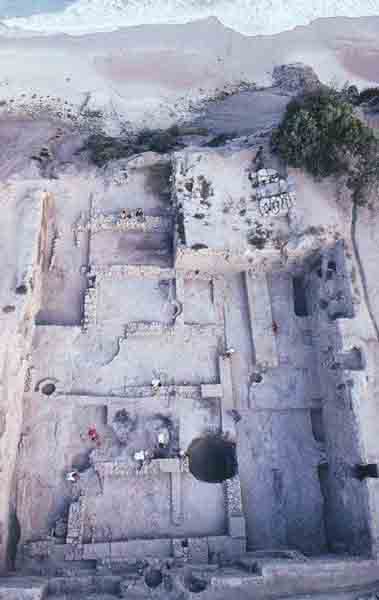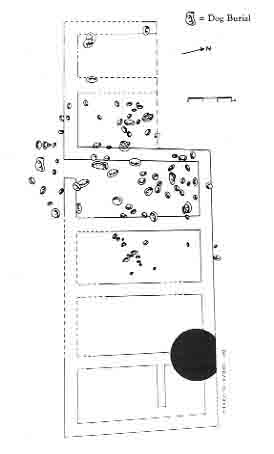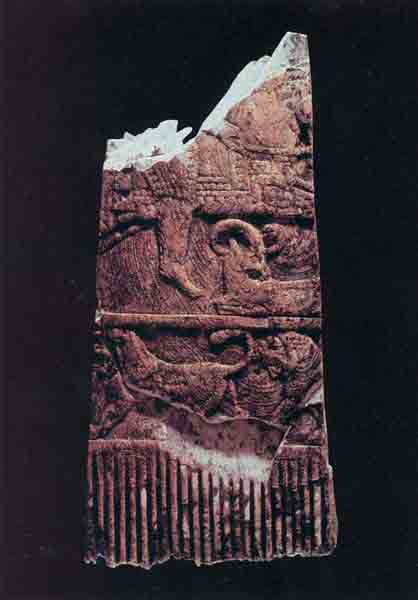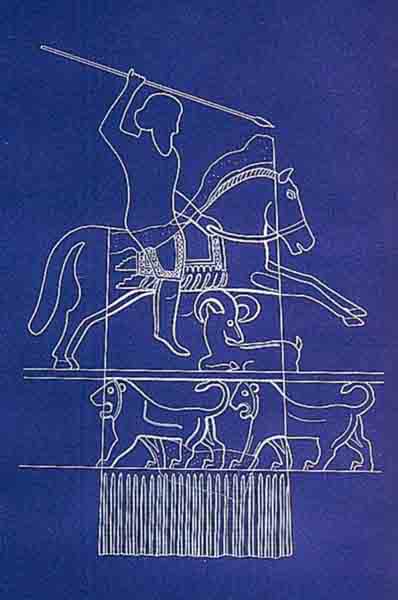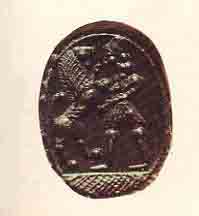Why Were Hundreds of Dogs Buried at Ashkelon?
026
027
This is part II of a three-part article. Part I appeared in the last issue (“When Canaanites and Philistines Ruled Ashkelon,” BAR 17:02). Part III will appear in the next issue (“Eroticism and Infanticide at Ashkelon,” BAR 17:04).
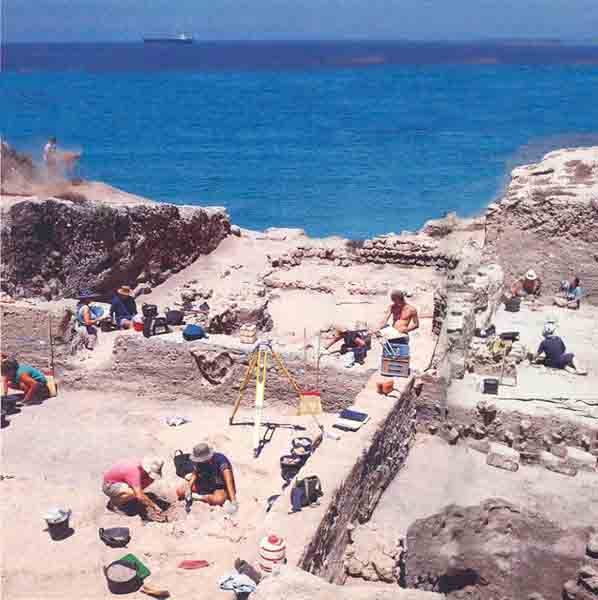
Ancient Ashkelon, now quietly nestled beside the Mediterranean in the south of Israel, is shaped like a giant 150-acre bowl, with the sea wearing away at much of the western half. The rim and sides of the bowl are formed by the mammoth Middle Bronze Age glacis, or rampart, that once protected the city. Inside the bowl are buried at least 20 ancient cities, dating from about 3500 B.C. to 1500 A.D., a span of 5,000 years.

In the last issue, we examined the Middle Bronze and Iron Age cities—the first, Canaanite and the second, Philistine.
In 604 B.C., Philistine Ashkelon was destroyed by the neo-Babylonian king Nebuchadrezzar (neb-uh-kuh-DREZ-uhr; also called Nebuchadnezzar [neb-uh-kuhd-NEZ-uhr]), whose army soon thereafter (in 586 B.C.) destroyed Jerusalem, capital of the kingdom of Judah, together with its Temple. Thus began what is known in Israelite history as the 028Babylonian Exile. Less widely known is the fact that the Philistines too were exiled to Babylon.
The Babylonians were replaced (in 538 B.C.) by the Persians, who expanded and then ruled the biggest empire the world had known before Alexander the Great—from the eastern Mediterranean to India. A more benign imperial power than the Babylonians—perhaps we may even characterize their hegemony as enlightened—the Persians under Cyrus the Great allowed the Jews to return to their land and even to rebuild their Temple (Ezra 1:2–4, 6:3–5).
No record exists, however, as to what happened to the exiled Philistines. Those who may have remained in Ashkelon after Nebuchadrezzar’s conquest apparently lost their ethnic identity. They simply disappear from history.
Culturally, Ashkelon once again became Canaanite—or, more precisely, Phoenician, as the coastal Canaanites are called at this time, having developed a culture of their own, supported by a far-flung commercial empire to the west.
During the Persian period (538–332 B.C.), the great Persian kings ruled the area politically, but they were not cultural imperialists. Even politically, they ruled with a comparatively gentle hand, giving rather wide latitude to local satrapies. In the heart of Phoenicia—the eastern Mediterranean coast, in what today is Lebanon—the Persians found willing allies among the Phoenicians, who provided their Persian overlords with naval power and wealth from the Mediterranean world and beyond.
For their cooperation, the Persians gave Phoenicians from Sidon and Tyre control of the coast as far south as Ashkelon. (Farther south, Gaza remained more a desert port than a Mediterranean seaport.) The Persians assigned governors for the coastal cities, cleverly alternating a Tyrian and a Sidonian governor for each major coastal city down to Ashkelon. According to a mid-to-late-fourth-century B.C. source,1 Ashkelon was known as a “city of the Tyrians” and headquarters of a Tyrian governor.
Phoenician culture—and therefore, we may assume, the Phoenicians—dominated Ashkelon by the late sixth or early fifth century B.C. This is evidenced by Phoenician inscriptions (one as early as about 500 B.C.), iconography characteristic of Phoenician religion (especially the sign of the goddess Tanit) and by the Phoenician pottery we excavated.

The Phoenicians brought with them to Ashkelon 029not only their culture. With their maritime and commercial skills, they also brought a great deal of prosperity to the port. In fact, the whole eastern coast of the Mediterranean prospered during the Persian period under the enterprising Phoenicians. This stands in sharp contrast to the comparatively impoverished province of Judah, or Yehud (ye-HOOD) as it was known in official Aramaic in the Persian period, with Jerusalem as its capital. In abundance of Persian-period remains, the contrast between the two areas is remarkable. Inland, in Yehud, Persian-period strata are very thin if not ephemeral. On the Mediterranean coast, Persian-period occupational debris is quite thick—6 to 10 feet at Ashkelon and at Dor to the north.

Within the huge bowl that is the tell at Ashkelon are two mounds, one in the northern part and one in the southern part of the site. On the north side of the southern mound (Grid 38), known as al-Hadra, nearly 10 feet of Persian-period occupational debris overlay the Philistine strata. The Persian-period sequence begins with monumental ashlara buildings that we have only partially excavated. Thereafter, we found at least five more phasesb or subphases of buildings, culminating in a major destruction in about 300 B.C. Rooms in the destroyed buildings were filled with burnt and fallen debris from the superstructure. In the debris were buried basket-handled amphorae (AM-fo-ree)c and a linen bag filled with Phoenician silver coins of the fourth century B.C.
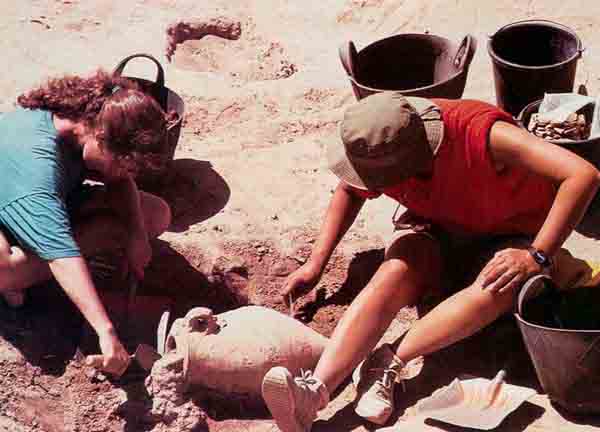

That the conflagration was widespread is clear from evidence in Grid 57 on the southwestern side of the city. Here we found the same phases and subphases of Persian-period occupation, beginning with a monumental structure built in about 500 B.C., followed by later phases of architecture, such as street-front workshops, culminating in a massive destruction. Shortly before the destruction of about 300 B.C., the inhabitants of one of the buildings secreted a hoard of silver coins and a silver bracelet. The coins were tetradrachmas (tet-ruh-DRAK-muhs) bearing the portrait of Alexander the Great. Nearby was a laurel-leaf crown of gold with 030side pieces of gilded bone. Several basket-handled amphorae stored on the second floor of one of the buildings collapsed onto the first floor. The basement was filled with burnt bricks, rubble and pottery of the late fourth century B.C.

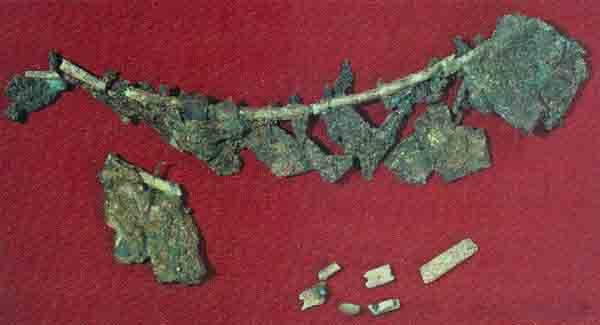
Because of the presence of a hoard of his coins, the citywide destruction must have occurred after Alexander the Great (356–323 B.C.) had conquered the Levant (about 332 B.C.). Ashkelon (but not Gaza) was apparently spared the destruction which accompanied Alexander’s conquest. But soon thereafter, in about 300 B.C. (although we cannot be certain until all of the data—pottery, coins, etc.—have been analyzed), Ashkelon too was devastated. This tragic episode must have occurred about the time Ptolemy I Soter (c. 367/6–283/2 B.C.) of Egypt was establishing his supremacy over the region, when Ashkelon was no longer under the control of Tyre.
In Grid 57 we also made one of the strangest discoveries of the entire excavation. In the phase following the construction of the monumental building mentioned previously, sandwiched in between that initial phase and the following architectural phase was a brief interlude (Phase 5 in Grid 57) when the floor area was leveled and used as a dog cemetery! We found a dozen dogs carefully buried here.
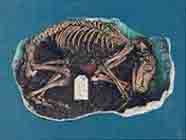
In nearby Grid 50 we uncovered an impressive building with six almost identical rooms. These rooms seem to be magazines of a large warehouse, about 30 by 60 feet. Each magazine had nearly 250 square feet of interior storage space. On the floors of the magazines, we excavated several Phoenician amphorae; Greek Attic Black-glazed ware; Red-figured as well as Black-figured fine ware, also from Greece; and a scapula (collar-bone) of a camel that was one of the basic raw materials from which fine bone artifacts were manufactured. The imprint of a basket containing red ocher was all that remained of perishable items. Other pigments, such as brown umber from Cyprus, were found stored nearby.
In its original construction, this large warehouse was stepped or terraced down toward the sea; the western half of the building’s stone foundations therefore lay at a lower level than the eastern half. In the next phase (Phase 7 in Grid 50, which corresponds to Phase 5 in Grid 57), this western area was leveled up with a series of rubbish-laden fills. But before the leveled area was next used as a warehouse (sometime in the last half of the fifth century B.C.), the deeper fills above the western half of the warehouse were put to a far different use: it was part of a huge dog cemetery that extended all the way to the 12 dog burials we had found in Grid 57. Moreover, the western limits of the dog cemetery could not be ascertained because that part had eroded into the sea.
Till now, we have found more than 700 partial or complete dog carcasses from the fifth century B.C., most of them buried in the western half of Grid 50. Because only the eastern limits of this dog cemetery have been established, we can speculate that it was originally much larger, with dog burials probably numbering in the thousands. This is by far the largest animal cemetery of any kind known in the ancient world.

031
Ashkelon’s dog cemetery was of extremely short duration, perhaps lasting no more than 50 years. Thereafter the area was returned to its previous mercantile use (though we have indications that dogs still received special burials elsewhere later in the Persian period). Nevertheless, in that short period, as many as three burials were found superimposed in some places, one dug into the other. This suggests that there were no burial markers over the graves.
Each dog carcass was carefully and individually placed in a shallow pit dug into the fill of what had previously been a warehouse. Each dog was deliberately placed on its side, its legs flexed and its tail tucked in around the hindlegs. The carcass was then carefully covered with earth containing a mixture of cultural debris. However, no grave goods can be associated with the dog burials.
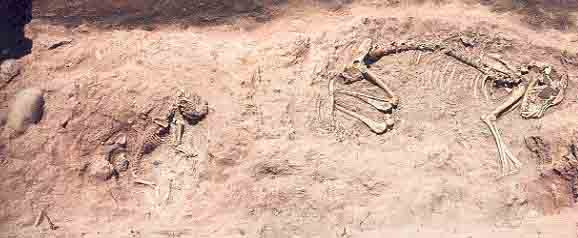
When undisturbed by later building activity or scavenging, the dog burials present a remarkably homogeneous picture. Actually, it was quite tedious (some would say boring) excavating them, each of which we had to excavate as carefully as the last.
About 60 to 70 percent of the dogs were puppies; the remainder were subadult and adult dogs. Our staff zooarchaeologists, Dr. Paula Wapnish and Professor Brian Hesse, of the University of Alabama in Birmingham, 032tell us that the skeletons lack any butchering marks, which indicates that the dogs died of natural causes. This is confirmed, according to them, by the fact that the mortality profile of the Ashkelon dogs is similar to that of urban dog populations today. Thus, it does not appear that these dogs were eaten (as the Persians accused the Phoenician Carthaginians of doing2). Nor does it appear that these dogs were offered as sacrifices, despite the implication in Third Isaiahd in a passage written shortly before the Ashkelon dog cemetery was established:
“Whoever slaughters an ox is like one who kills a human being; whoever sacrifices a lamb, like one who breaks a dog’s neck; whoever presents a grain offering, like one who offers swine’s blood; whoever makes a memorial offering of frankincense, like one who blesses an idol.” (Isaiah 66:3; New RSV)
The mature Ashkelon dogs were a little over 20 inches 038high and weighed a little more than 30 pounds—a dog population of medium height and build. Although no known modern breed correlates exactly with the Ashkelon dogs, Wapnish and Hesse have found a modern counterpart in today’s Bedouin sheepdogs, known as Palestinian pariah dogs. The best ancient representation of dogs similar to the Ashkelon dogs is probably the hound on the so-called Alexander Sarcophagus (late fourth century B.C.) from Sidon, on which Alexander the Great and his client, the king of Sidon, pursue a lion with a hunting hound of about the same size and build as the Ashkelon dogs. Like the dog on the sarcophagus, the Ashkelon hounds could have been used in hunting, to pursue hares, gazelles, wild goats or even lions.
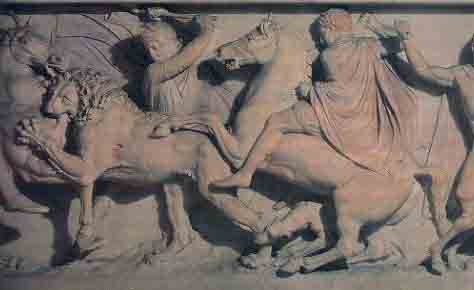
A critical datum: Newborn dogs and puppies were given the same careful mortuary treatment as more mature dogs. This concern for the proper burial of what in some cases were probably dog fetuses reflects an intense relationship between dogs and humans. Yet, because many of these dogs lived only for a short time, if at all, the attachment could not be based on mere companionship.
In classical Greek society, where dogs were greatly appreciated, poets sometimes wrote very moving epitaphs for dogs, to be inscribed on markers over the pet’s grave, as in this example penned by the poet Tymnes in about 300 B.C.
“The stone tells that it [the grave] contains here the white Milesian dog, Eumelos’ faithful guardian. They called him ‘Bull’ while he still lived, but now the silent paths of night possess his voice.”3
But in ancient Greece, as now, special burials were reserved for pets old enough for some kind of human bonding to have occurred. This could not have been the case for the majority of dogs buried at Ashkelon.
The best explanation seems to be that the Ashkelon dogs were revered as sacred animals. As such, they were probably associated with a particular deity and with that god’s sacred precinct, about which the dogs were free to roam.
I hasten to add that we have not yet found a shrine or temple associated with the dog cemetery. But most 039of the environs of the cemetery have not yet been excavated—and a substantial area to the west has collapsed into the sea.
The area occupied by the dog cemetery is significant. Throughout the preceding and the remainder of the Persian period, this ground was devoted to profit-making enterprises connected with the export-import business. But for a generation or so, this was interrupted by the dog cemetery, apparently devoted to ritual purposes.
Dog burials are extremely rare outside of Ashkelon, although in the same period at neighboring Ashdod, seven dog burials were recorded. Recently, a dog from the Persian period was found buried in a jar at Tell Qasile, in modern Tel Aviv.4 Several dogs were also found buried at Gezer, but these are a couple of centuries later, in the Hellenistic period.
Like many other ports and caravan cities, Ashkelon had a heterogeneous population throughout most of its history, comprised of local citizens and a variety of foreign merchants. In cosmopolitan Ashkelon of the Persian period, we should not be surprised to find Persians, Phoenicians, Philistines, Egyptians, Greeks and Jews. And the artifacts recovered in our excavations provide evidence for the presence of diverse elements in the city’s population from the mid-sixth through the fourth centuries B.C. The culture of any of these could provide clues to understanding the significance of the strange dog cemetery we found in the midst of this mercantile district.
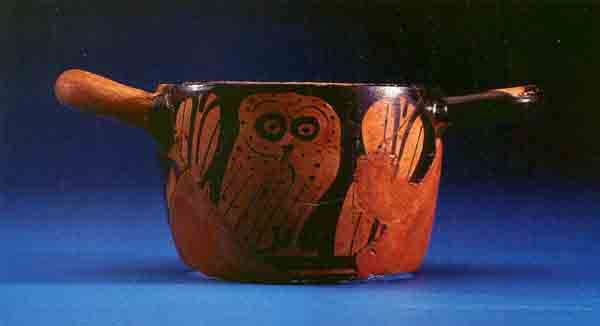

In the cosmology of the Persian Zoroastrians, dogs rank next to humans in both this world and the next. In Zoroastrian death rites, the priest gives an egg, a symbol of immortality, to a dog to eat. He then leads the dog to the home of the dead person, where the dog gazes at the corpse and then eats three pieces of bread from the chest of the corpse. After that, the dead body is washed and shrouded. Then for three days a dog vicariously eats three meals a day for the deceased. Then each day for the next 40 days, the canine vicar is fed three pieces of baked bread and a roasted egg at the house of the deceased.5
Although Persian reverence for dogs might have influenced the practice at Ashkelon, a Zoroastrian would not have laid the corpse of a human or a dog directly in the ground without a lining of stones or the like to protect the earth from the corpse, which was considered a highly charged pollutant.6 That the dogs in the Ashkelon cemetery were placed directly into the ground in unlined pits mitigates against the Zoroastrian association.
Moreover, the traces of Persian material culture in the West are minimal. At Ashkelon a beautiful ivory comb, with hunting scenes and rows of lions, recalls Persian Achaemenid art; a lead weight encased in a truncated shaft of decorated bone seems to conform to the Persian standard.7 But other than that, the immediate, direct impact of Persians on the material culture of the coast seems negligible.

What about the Egyptians? We know that the Egyptians were nearby and exported basketfuls of trinkets and amulets to Ashkelon. The Egyptians are well known for their reverence, even worship, of animals: they installed them in temples and devoted special precincts to their burials, although most were mummified for careers in the afterlife. Diodorus Siculus, writing in the first century B.C., mentions the dog among several animals venerated by Egyptians:
“For each kind of animal [including dogs] that is accorded this worship there has been consecrated a portion of land which returns a revenue sufficient for their care and sustenance…
“The sacred animals are kept in ‘sacred enclosures’ and are cared for by many men of distinction who offer them the most expensive fare… When one of these animals dies, they wrap it in fine linen and then, wailing and beating their breasts, carry it off to be embalmed…, [and then] they lay it away in a consecrated tomb.”8
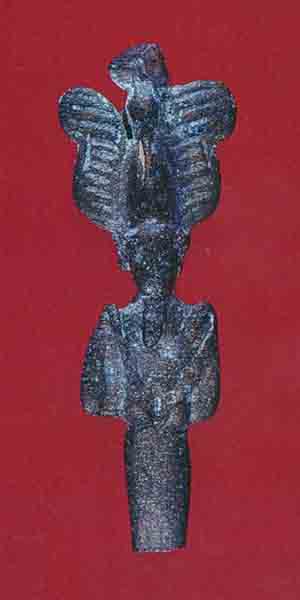
None of the buried dogs at Ashkelon, however, showed any signs of mummification.
Thus, although the Greeks, Egyptians and Persians could all be described as “canidophiles” (dog-lovers), I doubt that any one of these relatively small ethnic groups residing in Ashkelon could have accounted for the hundreds (if not thousands) of dogs buried here in the fifth century B.C. And neither the Greeks nor the Egyptians would have had the authority to convert prime real estate into a sacred precinct for dog burials.


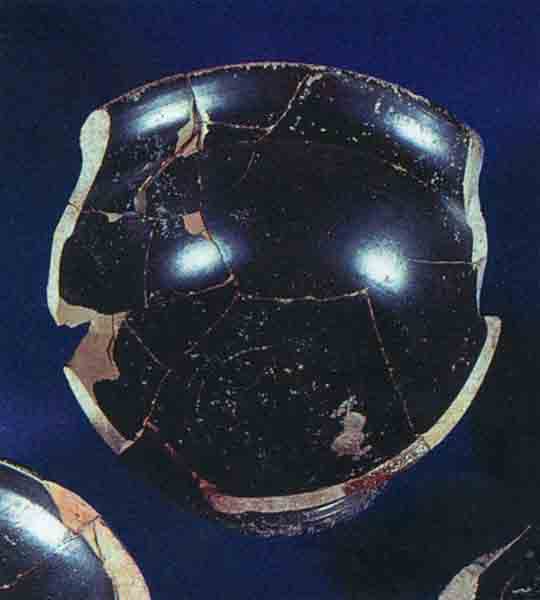
The only people with sufficient authority and a large enough population to account for so many dog burials in such a short time were the Phoenicians. Their material culture dominated Ashkelon throughout the Persian period. This is shown by the ubiquity of their religious symbols, such as the “sign of Tanit,” as well as their pottery and inscriptions. Although other ethnic groups, such as the Egyptians or the Persians, might have had an influence on Phoenician attitudes and ritual concerning dogs, it was the Phoenicians, I believe, who were responsible for the dog burials at Ashkelon and who considered the dog a sacred animal. The evidence for this inference—derived mainly from the archaeological remains—is, however, not conclusive. I describe it in some detail in the sidebar “Deities and Dogs—Their Sacred Rites.”

Presumably the dog became associated with healing because of the curative powers evident from licking its own wounds or sores. One neo-Assyrian text in cuneiform suggests that even touching the sacred dog was sufficient to heal: “If a man goes to the temple of his god, and if he touches… (?), he is clean (again?); likewise if he touches the dog of Gula [the goddess of healing], he is clean (again?).”9
Dogs were involved in healing cults in many different cultures in antiquity; their association with temples and healing deities was rather widespread in the ancient Mediterranean and Near Eastern worlds, whether it be Gula in Mesopotamia, Asklepios in Greece, Eshmun in Phoenicia, Mukol or Resheph-Mukol in Phoenician Cyprus, or, earlier still, at Late Bronze Age Beth-Shean. In Egypt sacred dogs participated in rituals where, according to Diodorus, the Egyptians “make vows to certain gods on behalf of their children who have been delivered from an illness, in which case they shave off 042their hair and weigh it against silver or gold, and then give the money to the attendants of the animals mentioned [including dogs].”10 According to the Kition plaque, discussed in the sidebar “Deities and Dogs—Their Sacred Rites,” it was the attendants who were paid for the services involving healing rites performed by the sacred “dogs and puppies” in the Phoenician temple at Kition.
This is also the context in which we should understand the Deuteronomist’s condemnation of those who bring the “wages of a dog into the house of Yahweh in payment for any vow” (Deuteronomy 23:18). There were probably healing cults involving sacred dogs operating in the vicinity of the Jerusalem Temple. It is in such a cultic context that I would—at least tentatively—understand the hundreds of puppy and dog burials at Ashkelon. We do not know the name of the deity with whom these sacred dogs were associated (Resheph-Mukol or Eshmun [= Asklepios]?—see the sidebar, “Deities and Dogs—Their Sacred Rites”) nor do we yet have the temple to which the dogs might have belonged. Until the temple or other cultic architecture is found, our hypothesis must be regarded as unconfirmed.
If anyone has a better explanation for the immense dog cemetery at Ashkelon, I would like to hear it.
This is part II of a three-part article. Part I appeared in the last issue (“When Canaanites and Philistines Ruled Ashkelon,” BAR 17:02). Part III will appear in the next issue (“Eroticism and Infanticide at Ashkelon,” BAR 17:04). Ancient Ashkelon, now quietly nestled beside the Mediterranean in the south of Israel, is shaped like a giant 150-acre bowl, with the sea wearing away at much of the western half. The rim and sides of the bowl are formed by the mammoth Middle Bronze Age glacis, or rampart, that once protected the city. Inside the bowl are buried at […]
You have already read your free article for this month. Please join the BAS Library or become an All Access member of BAS to gain full access to this article and so much more.
Already a library member? Log in here.
Institution user? Log in with your IP address or Username
Footnotes
We have not yet assigned site-wide strata numbers to the various phases within local grids (100 meters by 100 meters). Phase numbers apply only within each grid. The phase numbers are not necessarily the same from grid to grid, although eventually we may determine they are part of the same stratum.
The Book of Isaiah was written by different prophets at different times. Chapters 1–39 are pre-Exilic; that is, before the Babylonian Exile. The remainder (chapters 40–66) is post Exilic; it is attributed either to an anonymous Second Isaiah (deutero-Isaiah) or, in the opinion of some scholars, chapters 40–59 to Second Isaiah and chapters 60–66 to Third Isaiah (trito-Isaiah).
Endnotes
Pseudo-Scylax, Periplus; see Menachem Stern, Greek and Latin Authors on Jews and Judaism (Jerusalem: Israel Academy of Sciences and Humanities, 1984), vol. 3, p. 10.
Greek Anthology, transl. W.R. Patton, Loeb Classical Library (New York: G. P. Putnam’s Sons, 1917), vol. 2, p. 117, poem 211.
Mary Boyce, Zoroastrians: Their Religious Beliefs and Practices (London: Routledge and Kegan Paul, 1984), pp. 45ff.
After the original carvings on both sides of the ivory comb were made, the edges of the comb were, for some unknown reason, pared off. Dr. Abbas Alizadeh, associate director of the Leon Levy expedition, has restored the motifs on the basis of contemporary parallels from ancient Persia in the drawings which he produced. Dr. A. Eran staff metrologist, identified the weight as one karsha, a Persian unit equal to 10 shekels.
Diodorus Siculus, Bibliotheca historia (Library of History), transl. C.H. Oldfather, Loeb Classical Library (Cambridge, MA: Harvard Univ. Press, 1933), Book 1.83.2; 84.5; 83.5–6.
For a general survey of ancient Near Eastern and Mediterranean healing deities, such as Gula and Asklepios, see Hector Avalos, “Illness and Health Care in Ancient Israel: A Comparative Study of the Role of the Temple (Ph.D. dissertation, Harvard University, Cambridge, MA, 1991), chs. 1–2. Dr. Avalos translated the neo-Assyrian text.

